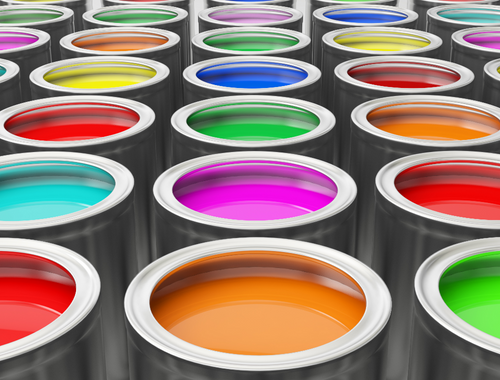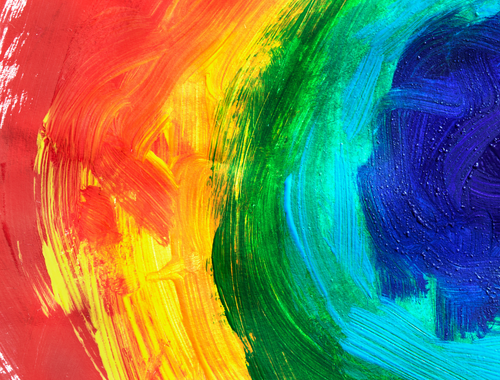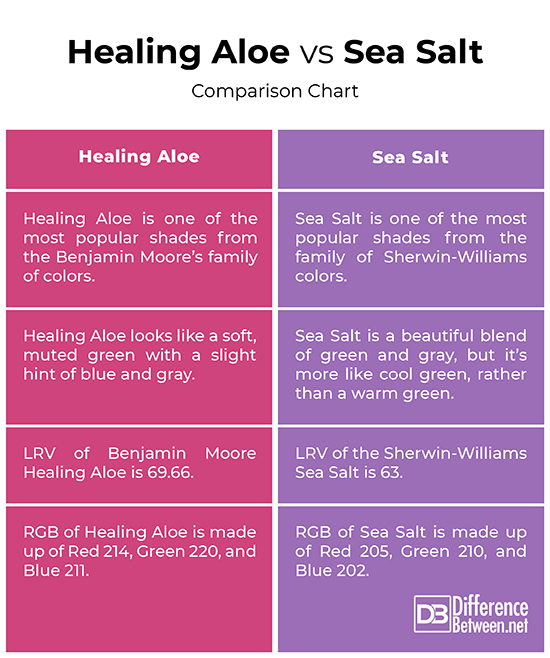Difference Between Healing Aloe and Sea Salt
Sherwin-Williams and Benjamin Moore are two of the biggest names in the American paint and coating industry. Both are premium paint manufacturers that provide a superb and innovative range of paints and coatings for interior and exteriors. So, if you’re looking for your next DIY paint project, you’re most probably considering either of the two brands. Both provide highest quality interior paints and colors to compliment your home décor. Both are known for their highest-grade paint solutions, so it’s tough to choose between the two. And two of the most popular shades Sherwin-Williams and Benjamin Moore offer are the Sea Salt and Healing Aloe respectively. Both are great shades perfect for interior paint. But which one should you choose?

Healing Aloe
The Healing Aloe (1562) is a gorgeous spa-like shade that is more like a light blue with notes of gray. The Healing Aloe is one of the most popular color shades from the Benjamin Moore’s family of colors. It is a refreshing shade of light blue or some would say green with a slight hint of gray. It is an absolutely stunning shade that is so light and versatile it pairs well with the colors and undertones of the fixed and furnished items in your house. It is absolutely warm and soothing, not so stark, and is muted. It looks like a soft, muted green with a slight hint of blue and gray, but it may look different depending on the backdrop, lighting, and décor. With a room that has a lot of windows in it, this color looks more washed out with a little overpowering shade of gray, which looks almost neutral. It may appear darker in artificial lights though.

Sea Salt
The Sea Salt (SW 6204) is one of the most popular shades from the family of Sherwin-Williams colors and it’s easy to see why. The Sherwin-Williams Sea Salt is a beautiful blue-green shade that looks blue in several different lighting conditions but it’s technically green. It is a beautiful blend of green and gray, but it’s more like cool green, rather than a warm green. It is an iconic shade of green that is soft and muted and goes well with fresh or muted color palettes. The combination of green and gray is so soothing and divine that it just effortlessly fits in with so many different color schemes, lighting conditions, and décor. RGB of Sea Salt is made up of Red 205, Green 210, and Blue 202. It has a fantastic depth to start with if you don’t know what color to pick and what depth you like. The Sea Salt makes your room look brighter and feel lighter.
Difference between Healing Aloe and Sea Salt
Shade
– The Healing Aloe is a refreshing shade of light blue or some would say green with a slight hint of gray. It looks like a soft, muted green with a slight hint of blue and gray, but it may look different depending on the backdrop, lighting, and décor. The Sea Salt is a beautiful blend of green and gray, but it’s more like cool green, rather than a warm green. It is closer to the yellowy side of green, and quite gray.
LRV
– LRV stands for “light reflectance value.” The LRV of a color or shade indicates the percentage of light a color reflects. It measures, on a scale of 0 (black) to 100 (white), how light or dark a shade will look. True black has an LRV of 0 and pure white has 100 LRV. Higher the LRV, the lighter the color is. Now, the LRV of the Sherwin-Williams Sea Salt is 63 whereas the LRV of Benjamin Moore Healing Aloe is 69.66. So, Healing Aloe is lighter than Sea Salt.
RGB
– RGB stands for Red, Green, and Blue. It indicates the value of red, green and blue on a scale of 0 to 255, with 255 signifies the highest possible concentration of the color. It signifies the intensity of the three colors. The higher the RGB values, the lighter the color. That being said, RGB of Sea Salt is made up of Red 205, Green 210, and Blue 202, whereas the RGB of Healing Aloe is made up of Red 214, Green 220, and Blue 211.
Healing Aloe vs. Sea Salt: Comparison Chart

Summary
In a nutshell, both are two different colors that come from different family of color collections. Both are quite popular among paint manufacturers and color designers. May be both look somewhat same, but there are subtle differences between the two shades. For one, Healing Aloe looks like a soft, muted green with a slight hint of blue and gray. Sea Salt is a blend of green and gray, but it’s more like cool green, rather than a warm green. Sea Salt has blue gray undertones whereas Healing Aloe has undertones of blue, green, and gray.
Is Sherwin Williams Sea Salt warm or cool?
Sea Salt is a blend of green and gray, but it’s more like cool green, rather than a warm green.
Is Healing Aloe a warm or cool color?
Healing Aloe is a refreshing shade of light blue with notes of gray. It is a cool color with a hint of green and gray.
What undertones does Benjamin Moore Sea Salt have?
Sea Salt has blue gray undertones whereas Healing Aloe has undertones of blue, green, and gray.
Does Sherwin Williams Sea Salt look blue?
Sea Salt is a beautiful blend of green and gray, but it’s more like cool green, rather than cool blue.
- Difference Between Caucus and Primary - June 18, 2024
- Difference Between PPO and POS - May 30, 2024
- Difference Between RFID and NFC - May 28, 2024
Search DifferenceBetween.net :
Leave a Response
References :
[0]Sadana, Nisitha. “Benjamin Moore Healing Aloe 1562 – The Serene Hue to Alleviate Your Soul.” KnockOffDecor, https://knockoffdecor.com/benjamin-moore-healing-aloe/. Accessed 29 Oct. 2022.
[1]Hershman, Susan. House Colors. Utah, United States: Gibbs Smith, 2009. Print
